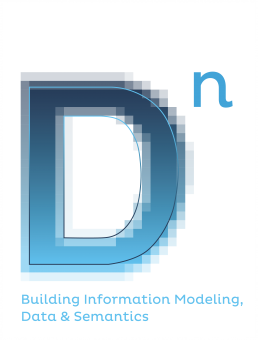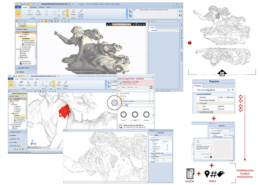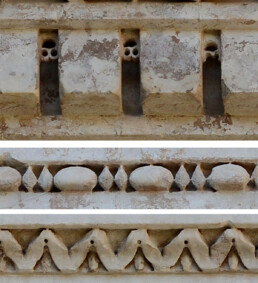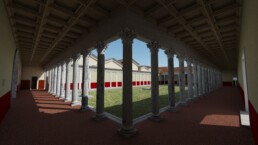The semi-automatic generation of HBIM elements: VPL approaches compared
ABSTRACT
The paper addresses the topic of parametric modeling applied to the field of Historic Building Information Modeling (HBIM).
The tools presented offer a possible answer to three-dimensional modeling problems in a BIM environment using different visual programming applications (VPLs) and their potential. Different solutions have been developed using diverse VPL applications depending on the input data type, whether unstructured or structured within a spreadsheet.
Elisabetta Caterina Giovannini
Dipartimento di Architettura e Design, Politecnico di Torino
HBIM system for Restoration and Conservation of Artworks.
ABSTRACT
The paper shows the results of an HBIM process to support planning, management, implementation and archiving of activities, pre, during and post-restoration of movable or immovable of artistic manufact and decorative apparatus characterizing architectural and Historical-Artistic Heritage.
Emanuela Lanzara (1), Simona Scandurra (2)
(1) Università Suor Orsola Benincasa di Napoli, Dipartimento di Scienze Umanistiche
(2) Università degli Studi Federico II di Napoli, Dipartimento di Architettura
Metaverse and Cultural Heritage: first Investigations between Potential and Criticality
ABSTRACT
The contribution presents preliminary considerations on adopting the metaverse for cultural heritage, based on exploring different platforms and evaluating their level of development. The metaverse appears as an opportunity to maximise the accessibility of three-dimensional content, both for heritage replicas and new exhibition spaces. On the other hand, one must recognise the methodological criticalities due to adopting an environment created without scientific purposes.
Matteo Flavio Mancini, Laura Farroni
Università degli Studi Roma Tre – Dipartimento di Architettura
HBIM for information management of diagnostics in conservation projects: the case of the St. John Monastery in Müstair
ABSTRACT
This paper describes a project integrating HBIM methodology with a portion of the diagnostic data collected by the MOLAB campaign, a mobile laboratory of the European Research Infrastructure on Heritage Science E-RIHS, to study and preserve the monastery church of St. John in Müstair.
Camilla Tennenini(a)(c)*, Lorenzo Gatto(a), Michele Calvano(b), Letizia Martinelli(b), Filippo Calcerano(b), Elena Gigliarelli(b)
(a) Sapienza Università di Roma, Master HBIM 2023
(b) Istituto di Scienze del Patrimonio Culturale, Consiglio Nazionale delle Ricerche (ISPC-CNR)
(c) Fondazione Pro Monastero di San Giovanni
* present address: ETH Zürich, Institute for Building Materials, Physical Chemistry of Building Materials, Switzerland
Index Volume 11
INDEX
Digital models for built heritage representation and management
S. Cursi, L. Martinelli, F. Calcerano, M. Calvano, L. Cessari, E. Gigliarelli
Revixit Aquinum. How technologies can enhance cultural heritage
T. Empler, V. Malakuczi, G. Murro
Enriched cooperative systems in HBIM platforms for the management of cultural heritage
A. Sanseverino, S. Antinozzi, A. di Filippo
Non-regular serialities: imperfect recurrencies in the HBIM model
G. M. Valenti, A. Martinelli
Depth of information content in HBIM procedures
E. D’Angelo, M. Calvano
Enriched cooperative systems in HBIM platforms for the management of cultural heritage
ABSTRACT
This paper proposes a reflection on the definition of Monitoring Enriched COoperative Systems (ECO-Systems) based on integrated digital survey data aimed at the management of the built heritage. An algorithmic procedure is presented for the standardisation of Scan-to-BIM and Mesh-to-BIM processes.
(1,2)Anna Sanseverino, (1) Sara Antinozzi, (1) Andrea di Filippo
(1) Dipartimento di Ingegneria Civile, Università degli Studi di Salerno
(2) Dipartimento di Ingegneria Civile e Architettura, Università degli Studi di Pavia
Editorial Vol. 11
For an update on the latest experimentation techniques and the new research goals achieved in the BIM and H-BIM fields, this issue contains articles that can provide numerous ideas for inspiration and very useful insights.
BIM is an innovative approach to thinking about the project, to deal with it in all its aspects, to optimize operational processes, to standardize the design in an exhaustive production cycle for all the players involved, from the designer to the client. And if until now it has been thought of exclusively associated with “Building”, today it finds applications in very different sectors, from infrastructures to smart cities.
At the basis of BIM development there is interoperability not only between the actors involved but above all between the software used by the same actors. Standardization, therefore, is particularly important in this process and, because of this, international service agencies have been set up in charge of researching the standardization of the BIM process from 1D to 7D in the Cultural Heritage sector, in the engineering sector and in the urban sector.
In recent years, the experiments published in international journals, conference proceedings and websites have been countless and always one step ahead of the previous ones. This magazine, on the national scene, plays a fundamental role in updating the experimental procedures conducted in the BIM field and this issue in particular, addresses the multiple BIM applications in a new and original way.
Take, for example, the experiments conducted by Valeria Croce who propose a new BIM methodology in synergy with Artificial Intelligence. The experimentation addresses the possibility of automating Scan-to-BIM workflows by combining semantic segmentation methods that take advantage of AI and graphical algorithm editors for 3D modeling. The ML algorithms, created by exploiting the appropriate manipulation, export and extraction of geometric and visual descriptors (features) from 2D or 3D raw data, significantly reduce the manual annotation phase, avoiding arbitrary and too subjective choices in the interpretative phase.
In the contribution of Cursi et al. a variety of applications of HBIM describe a methodology for the semantic enrichment of models through external resources, making explicit the documentary approach of the information system in which information is stored to preserve, share and transmit the constructive knowledge of the built and heritage in a computable digital environment.
Empler et al. propose a VR and AR experimentation in the Revixit Aquinum Baths where the communicative power of digital is the protagonist with 3D mapping experiments.
For the experimentation of an optimization procedure to verifying the state of conservation of the architectural asset, one can consult the contribution of Anna Sanseverino et al., where it is clear that the management of the historical heritage cannot disregard an accurate investigation of the state conservation of materials and a detailed 3D reconstruction. The morphological and colorimetric reconstruction of complex structures, elements and specific damaged areas in a BIM environment is essential for the development of databases suitable for data archiving and capable of supporting the planning of renovations and, in general, of any intervention on the property under study.
Another problem, not of little importance, is the one addressed by Graziano Mario Valenti and Alessandro Martinelli, linked to the representation in BIM of irregular serialities, very present in the historical architectural heritage, which is undoubtedly an increasingly emerging theme, the more the need to create models more and more adherent to the case study is growing.
Finally, the issue closes with the contribution of Elena D’Angelo and Michele Calvano where the interoperability between the BIM model and the Public Administration is analysed.
The themes of representation are therefore reconfigured through this collection of research, explaining how the theme of parametric modeling is changing the frontier of design towards an interoperability of models. The recalibration of the graphic components and the updating of the representative standards within the parametric modeling produce a renewed attention to the models themselves and to their possibility of representing reality and simplifying some aspects, as a critical synthesis, in favor of a greater baggage of contents that are associated with them.
Laura Inzerillo, Sandro Parrinello
Depth of information content in HBIM procedures
ABSTRACT
The contribution proposes tools to represent the distinct morphological and semantic conditions of historical buildings (materials and technologies, decay patterns and damages) in an HBIM process, advancing possible solutions also in response to what the standard defines as information needs.
Elena D’Angelo, Michele Calvano
ISPC Istituto di Scienze del Patrimonio Culturale, Consiglio Nazionale delle Ricerche
Non-regular serialities: imperfect recurrencies in the HBIM model
ABSTRACT
In HBIM modeling it is common to have to represent elements that appear arranged in series and equidistant, but which are not, due to inaccuracies that we can consider to be mainly of a constructive type. To represent this variety, some solutions are exemplified here, ranging from precise and articulated direct modeling activities, up to indirect modeling procedures developed with Visual Programming Language.
Graziano Mario Valenti, Alessandro Martinelli
Sapienza Università di Roma
Revixit Aquinum. How technologies can enhance cultural heritage
ABSTRACT
The research has as the aim to enhance, through the use of ICT (Information and Communications Technologies), the archaeological assets of the Roman city of Aquinum, and in particular the monumental complex of the “Central Baths”. The enhancement strategies through ICT envisage a widespread diffusion of devices/set-ups that follow the principles of Virtual/Augmented Reality, enriching the visualizations with a storytelling and gamification process, which can also be used on visitors’ own devices, to promote the diffusion on social media. The research is scalable and envisages the development of technological solutions that can be used transversally to enhance all the assets involved, taking into consideration the future replicability in other places of culture in the Liri Valley.
Tommaso Empler, Viktor Malakuczi, Giovanni Murro
Sapienza Università di Roma









